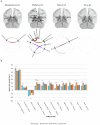Resting-state functional connectivity in anxiety disorders: a multicenter fMRI study
- PMID: 39367057
- PMCID: PMC11919712
- DOI: 10.1038/s41380-024-02768-2
Resting-state functional connectivity in anxiety disorders: a multicenter fMRI study
Abstract
Anxiety disorders (AD) are associated with altered connectivity in large-scale intrinsic brain networks. It remains uncertain how much these signatures overlap across different phenotypes due to a lack of well-powered cross-disorder comparisons. We used resting-state functional magnetic resonance imaging (rsfMRI) to investigate differences in functional connectivity (FC) in a cross-disorder sample of AD patients and healthy controls (HC). Before treatment, 439 patients from two German multicenter clinical trials at eight different sites fulfilling a primary diagnosis of panic disorder and/or agoraphobia (PD/AG, N = 154), social anxiety disorder (SAD, N = 95), or specific phobia (SP, N = 190) and 105 HC underwent an 8 min rsfMRI assessment. We performed categorical and dimensional regions of interest (ROI)-to-ROI analyses focusing on connectivity between regions of the defensive system and prefrontal regulation areas. AD patients showed increased connectivity between the insula and the thalamus compared to controls. This was mainly driven by PD/AG patients who showed increased (insula/hippocampus/amygdala-thalamus) and decreased (dorsomedial prefrontal cortex/periaqueductal gray-anterior cingulate cortex) positive connectivity between subcortical and cortical areas. In contrast, SAD patients showed decreased negative connectivity exclusively in cortical areas (insula-orbitofrontal cortex), whereas no differences were found in SP patients. State anxiety associated with the scanner environment did not explain the FC between these regions. Only PD/AG patients showed pronounced connectivity changes along a widespread subcortical-cortical network, including the midbrain. Dimensional analyses yielded no significant results. The results highlighting categorical differences between ADs at a systems neuroscience level are discussed within the context of personalized neuroscience-informed treatments. PROTECT-AD's registration at NIMH Protocol Registration System: 01EE1402A and German Register of Clinical Studies: DRKS00008743. SpiderVR's registration at ClinicalTrials.gov: NCT03208400.
© 2024. The Author(s).
Conflict of interest statement
Competing interests: The authors declare no competing interests.
Figures


Similar articles
-
Comparison of Resting-State Functional Connectivity Between Generalized Anxiety Disorder and Social Anxiety Disorder: Differences in the Nucleus Accumbens and Thalamus Network.Brain Connect. 2024 Oct;14(8):445-456. doi: 10.1089/brain.2024.0034. Epub 2024 Aug 28. Brain Connect. 2024. PMID: 39135472
-
Disrupted amygdalar subregion functional connectivity and evidence of a compensatory network in generalized anxiety disorder.Arch Gen Psychiatry. 2009 Dec;66(12):1361-72. doi: 10.1001/archgenpsychiatry.2009.104. Arch Gen Psychiatry. 2009. PMID: 19996041
-
Common neural patterns of substance use disorder: a seed-based resting-state functional connectivity meta-analysis.Transl Psychiatry. 2025 Jun 4;15(1):190. doi: 10.1038/s41398-025-03396-2. Transl Psychiatry. 2025. PMID: 40467551 Free PMC article.
-
Altered brain connectivity in hyperkinetic movement disorders: A review of resting-state fMRI.Neuroimage Clin. 2023;37:103302. doi: 10.1016/j.nicl.2022.103302. Epub 2022 Dec 24. Neuroimage Clin. 2023. PMID: 36669351 Free PMC article.
-
Advancements in the study of large-scale network alterations in brain functional connectivity among individuals with bipolar disorder.Neuroscience. 2025 Aug 6;580:249-260. doi: 10.1016/j.neuroscience.2025.05.007. Epub 2025 May 4. Neuroscience. 2025. PMID: 40328348 Review.
Cited by
-
Effect of a single dose of lorazepam on resting state functional connectivity in healthy adults.Brain Imaging Behav. 2025 Jul 12. doi: 10.1007/s11682-025-01043-4. Online ahead of print. Brain Imaging Behav. 2025. PMID: 40646404
-
Event cache: An independent component in working memory.Sci Adv. 2025 May 23;11(21):eadt3063. doi: 10.1126/sciadv.adt3063. Epub 2025 May 23. Sci Adv. 2025. PMID: 40408491 Free PMC article.
-
Glymphatic Function as a Prognostic Biomarker in Prolonged Disorders of Consciousness.CNS Neurosci Ther. 2025 Jul;31(7):e70526. doi: 10.1111/cns.70526. CNS Neurosci Ther. 2025. PMID: 40702739 Free PMC article.
-
Longitudinal changes in infant attention-related brain networks and fearful temperament.Biol Psychiatry Cogn Neurosci Neuroimaging. 2025 Jul 18:S2451-9022(25)00219-8. doi: 10.1016/j.bpsc.2025.07.003. Online ahead of print. Biol Psychiatry Cogn Neurosci Neuroimaging. 2025. PMID: 40684940
-
Resolving heterogeneity in first-episode and drug-naive major depressive disorder based on individualized structural covariance network: evidence from the REST-meta-MDD consortium.Psychol Med. 2025 Jun 24;55:e174. doi: 10.1017/S0033291725100664. Psychol Med. 2025. PMID: 40550749 Free PMC article.
References
-
- Wittchen HU, Jacobi F, Rehm J, Gustavsson A, Svensson M, Jönsson B, et al. The size and burden of mental disorders and other disorders of the brain in Europe 2010. Eur Neuropsychopharmacol. 2011;21:655–79. - PubMed
-
- Whiteford HA, Degenhardt L, Rehm J, Baxter AJ, Ferrari AJ, Erskine HE, et al. Global burden of disease attributable to mental and substance use disorders: findings from the Global Burden of Disease Study 2010. Lancet. 2013;382:1575–86. - PubMed

